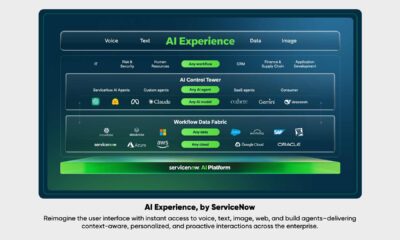Financial News
The Balancing Act of Financial Organizations to Compete in a Technology-Driven World
Written by: Ricardo Ferreira, EMEA Field CISO, Fortinet
Digital acceleration is impacting how we work, live, and consume services. In addition, the digital evolution of Financial Services Organizations (FSOs) raises essential questions about the future of banking. One looming concern is how FSOs will compete against fintechs, including addressing the need for innovation to improve customer experience.
Adapt to changing times
The top three strategic areas outlined in the IDC Infobrief, sponsored by Fortinet, “Accelerating Transformation Through Cybersecurity in Financial Services,” highlight the core priorities for financial institutions: Trust, Security, and Resilience. So, the question is, how can FSOs lead and win through innovation while ensuring that risks do not overwhelm a traditionally risk-averse industry?
Many FSOs have begun adopting new digital business models to help them thrive in a digital-first economy. These include prioritizing investments in key areas such as data-driven security, legacy modernization, and personalized and contextual customer experiences. But for these business models to work, they will need to rely on data, analytics, and cloud platforms.
So, when we ask, “what does success look like for the future-ready bank?” we see three major themes:
- Automation and cost reduction: Automation, managed services, and cloud platforms will enable FSOs to innovate faster. Automation allows business units to integrate with the rest of the organization, build self-service, and reduce manual labor costs, such as adopting Robotic Process Automation and artificial intelligence-powered chatbots to deal with insurance claims. In investment banking, robot advisors use machine learning-powered algorithms to help retail investors make better decisions. Thanks to cloud platforms and managed services, these new products and services are economically feasible because they shift traditional CapEx to activities that create more value.
- Customer intelligence and centricity: New platforms provide data and analytics for anticipating customer needs and hyper-personalizing the customer journey. Customer data, such as investment patterns, can guide a robot advisor to recommend portfolio choices aligned to customer preference. Similarly, natural language processing can help an AI system quickly assess a customer’s issue to redirect them to the nearest branch or get the appropriate representative involved.
- New value propositions: Open banking was a massive change for banks, helping them realize the power of APIs. Building Banking as a Service (BaaS) has allowed them to develop new services and create stronger partnerships.
But what about the customer experience?
Who is not irked when reminded of their first troubled mobile banking experience, with terrible UX and lack of integration? It’s why, when some fintechs launched their online mobile banking, it was a beacon of light in a dark room. A real-world security example that everyone might remember was the usage of biometrics for accessing online mobile banking. Big brands took a long time to adopt it, and while it might seem trivial from a UX perspective, it’s leaps and bounds towards progress.
Today, traditional brands regularly launch products that emulate offerings from nimbler fintech organizations. The lesson is clear: to gain a competitive advantage, banks must focus on creating a fast, intuitive, and seamless customer experience.
Are clouds grey in banking?
These business models require the accelerated consumption of new platforms, such as cloud computing. Financial organizations must understand they can create differentiated value and increase competitiveness by using the cloud to increase their speed of innovation and accelerate the go-to-market of new services and products.
Cloud platforms also serve as a bridge to modernize financial organization workloads. CIOs want to migrate workloads cohesively while ensuring the capabilities from their on-prem solutions are still available. Major Cloud Service Providers (CSPs) have jumped at the opportunity to integrate their environments into the same control plane.
Yes, but isn’t that risky?
Regulators have flagged the concentration risk. For example, the Bank of England has highlighted it in their stability reports. The latest Financial Conduct Authority (FCA) PS21/3 rules address third-party risk and operational resilience. And the European Union has gone a big step beyond with its Digital Operational Resilience Act (DORA).
All these activities and proposals are designed to address these concerns. The European Systemic Risk Board has flagged cyber as a systemic risk to the European financial system due to the increase in cyberattacks—especially in the financial industry, which is 300 times more likely to be the target of cyberattacks. The International Monetary Fund (IMF) emphasizes that cyber events propagate risk through the entire financial system via three broad transmission channels: risk concentration, risk contagion, and erosion of confidence.
That is why cybersecurity is a priority as part of the EU’s “Europe fit for the digital decade” policy program. Programs such as EU-HYBNET, ACCORDION, and DORA for financial services ensure Europe works as a single entity by harmonizing requirements to increase resilience and protect citizens.
What can financial organizations do about it?
To start, security needs to be woven into transformation efforts to ensure that innovation and transformation are conducted securely. For this to work, security must be included from a project’s inception, not as a bolt-on after a project and its services are launched.
What about protecting financial assets?
55% of European financial organizations already use some form of zero-trust strategy for their authorization and authentication. Zero-trust shifts the traditional paradigm from the implicit trust for users and resources inside a static, network-based perimeter to an authentication model that focuses on users, assets, and resources. Zero-trust requires authentication and authorization to be performed every time access is granted to a specific resource.
How do we address the ‘weakest link’ problem?
While people are an organization’s most critical asset, they are also the primary source of data breaches and network compromise. Organizations must be prepared for a loss of control if their workforce is not educated on cyber awareness. Some large financial organizations have created partnerships with e-learning portals and vendors to provide tailored courses using nudges and financial instruments to reskill the workforce with new technologies. Similarly, financial organizations must plan to mitigate the rampant cybersecurity skills shortage, which will impact 90% of organizations by 2025, resulting in delays in the transformational journey.
What can we do?
Digital acceleration is essential for competing in today’s financial marketplace. However, it doesn’t come without risk. First, ensure employees are trained and reskilled in the organization’s technologies. Second, share data with industry peers to learn best practices and identify potential issues. Transaction Monitoring Netherlands (TMNL) is an excellent example of transaction data sharing to mitigate Anti-Money Laundering (AML).
Finally, work with vendors and partners committed to cross-vendor openness and integration. When vendors work together across the threat landscape, the sum of their products is greater than the individual parts, deepening your level of cyber protection.
Financial
Finastra’s Saudi Arabia Reimagine Banking Forum Spotlights Innovation, Trust, and AI in a Vision 2030 Financial Landscape

Finastra, a global leader in financial services software, brought together regulators, banks, fintechs, and technology leaders at the Saudi Arabia Reimagine Banking Forum in Riyadh to examine how the Kingdom’s financial sector can accelerate innovation while protecting trust, resilience, and customer value under Vision 2030.
The forum featured perspectives from regional and global experts, including Rudy Kawmi, Vice President for Middle East, Africa and Asia Pacific, Universal Banking at Finastra, along with senior leaders such as Abdulkarim Alsowaygh, Head of Advisory Services at TechArch, and Aymen Belhedi, Digital and Technology Transformation Leader at KPMG Middle East.
As the conversation turned to how banks can turn ideas into action, Finastra shared perspectives based on its long-standing work with financial institutions in the Kingdom, where it has supported banks since the early nineties through local expertise, established relationships and ongoing investment. The company referenced the role of modern core platforms like Essence, in supporting agility, compliance and customer-centric design. Finastra Essence was also recognized as a Leader for the 2nd consecutive time in the Gartner Magic Quadrant for Retail Core Banking Systems, Europe.
Across three panel discussions – Banking Today: Delivering delight in a hyper competitive world, Banking Tomorrow: Innovation, agility and relevance, and Practical AI: Leveraging AI for profit, safely and securely – speakers shared practical strategies to balance regulatory expectations, customer needs, and technology adoption.
Key insights from the Saudi Arabia Reimagine Banking Forum include:
Innovation anchored in trust and compliance
Panelists agreed that innovation in Saudi banking must begin with trust. Cybersecurity, regulatory alignment and security maturity were described as non-negotiables, not afterthoughts. Speakers highlighted the role of the Saudi Central Bank (SAMA) in setting clear guardrails through initiatives such as API-driven banking frameworks and the Regulatory Sandbox, enabling banks and fintechs to experiment in controlled environments while protecting consumers and financial stability.
From product proliferation to precision, lifestyle-integrated banking
The discussion underlined a shift from launching more products to delivering precise, contextual experiences. Banks in Saudi Arabia are under pressure to evolve from traditional service providers into lifestyle platforms that integrate payments, credit and everyday services into the digital journeys customers already use. With the risk of banking drifting into a utility model, where providers are interchangeable, panelists called on institutions to differentiate through relevance, immediacy and purposeful design, not just scale.
Ecosystem orchestration as the new competitive edge
Speakers stressed that no institution can innovate in isolation. Banks that act as ecosystem orchestrators, curating fintech, technology and cybersecurity partners while owning the “trust layer”, are better positioned to deliver new propositions quickly. Internal teams, advisors and partners form a single value chain. The conversation moved beyond capability lists toward how those capabilities are combined, governed and brought to market at speed.
Data and AI turning trusted information into intelligence
Data was described as a critical and often underused asset. Panelists highlighted that the real opportunity lies not in collecting more data but in converting trusted data into actionable intelligence. In this context, AI and generative AI can help banks move from reactive service models to proactive, personalized engagement, provided governance keeps pace. With the right tools and controls, small teams can now deliver improvements in productivity and customer experience that previously required much larger workforces.
Practical, ethical AI with humans firmly in the loop
The AI discussion focused heavily on ethics, explainability and human oversight. Panelists warned against black-box systems in areas such as credit decisions and collections, where AI outcomes directly affect people’s lives. They emphasized the need to identify and address bias in training data and to keep humans accountable for final decisions. AI was positioned as a powerful tool to automate repetitive tasks, assist agents and accelerate analysis, while freeing people to concentrate on higher value work.
Technology is available, but adoption remains gradual
Speakers noted that while the technology to support next-generation services is already in place, adoption timelines can vary. Some innovations introduced in pilot phases have taken time to progress to full rollout, reflecting the sector’s careful approach to implementation. The discussion highlighted opportunities for continued progress in areas such as real time, transparent cross-border payments and fully digital account opening that reduces the need for in-branch processes.
Across all sessions, there was a consistent message: Saudi Arabia is setting a high bar for responsible innovation by combining a progressive regulator, a clear national agenda and banks that are re-architecting for trust, speed and inclusion. The future of banking in the Kingdom will belong to institutions that innovate boldly, design for resilience, and earn customer trust every day.
Financial
Rostro Group Enters UAE with New SCA Licence Amid the Country’s 20% Fintech Growth Surge

Rostro Group, an international diversified fintech and financial services group, has obtained a Category 5 license from the UAE Securities and Commodities Authority (SCA), marking a significant step in its long-term commitment to shape the UAE’s future financial ecosystem.
The UAE’s fintech ecosystem continues to expand at an exceptional pace, supported by progressive regulation, rising investor appetite, and strong government initiatives. Recent industry reports from bodies such as the MENA Fintech Association and Magnitt indicate that the UAE consistently attracts over 40–45% of all fintech investments in the region, reinforcing its position as the leading fintech hub in MENA.
Looking ahead, the sector in the UAE is projected to grow at a compound annual rate of more than 20% over the next five years, driven by increasing adoption of digital payments, rapid expansion in wealth-tech and digital brokerage services, and continued regulatory enhancements from bodies such as the SCA and ADGM. With this momentum, the UAE is well-positioned to remain a regional centre of innovation, capital formation, and digital financial transformation.
With UAE Securities and Commodities Authority (SCA) strengthening oversight and raising industry standards, the approval recognizes Rostro Group as a compliant and trusted participant in the country’s expanding financial landscape. It also allows the Group to operate in line with UAE’s expectations for transparency, investor protection and responsible market engagement.
Based in the UAE, the Group is led by CEO Michael Ayres, who has long-standing experience in the region’s fintech sector. Speaking about the SCA approval, Ayres highlighted that Dubai and Abu Dhabi’s rapid evolution into a future-ready financial ecosystem is unmatched.
Ayres said, “We at Rostro Group see the UAE as one of the most forward-thinking financial centres, one that will soon rival leading centres like London, Singapore or New York. Securing this licence deepens our alignment with the country’s vision to build a tech-first, institutionally robust financial ecosystem and propels our contribution to its next phase of growth.”
Rostro Group’s multi-brand structure is built to serve diverse categories of investors through a unified global ecosystem. Its Scope Prime division supports institutional clients with industry leading trading infrastructure, while Scope Markets offers individuals streamlined access to global trading and investing opportunities.
In recent years, the product offering of Rostro Group has been widened to include access to over 60 regional CFD equities, as well as the development of proprietary CFD indices to mirror the performance of the Dubai and Abu Dhabi stock markets.
Local banking relationships have already been established. In addition, Rostro’s Scope Prime division is now ready to provide multi-asset prime brokerage services to financial institutions across the GCC, whilst the retail client-facing Scope Markets division has the ability to offer account types denominated in multiple currencies including AED and USD.
Financial
StashAway broadens private market access for UAE-based HNWIs amid strong growth

High-net-worth investors now account for over 75% of UAE deposits, and StashAway is responding with new semi-liquid portfolios that broaden access to private markets.
StashAway, a wealth management platform, is offering UAE-based high-net-worth individuals (HNWIs) greater opportunities to build long-term wealth through private markets1. The move follows a year of strong growth among its high-net-worth clients, with this segment driving over 75% of its growth in the UAE over the past 12 months.
The new semi-liquid offerings – private infrastructure and private equity portfolios – are managed by Hamilton Lane, a global private market specialist with over US $956 billion in assets under management. With these portfolios, investors will benefit from significantly lower minimums, lower fees, and monthly liquidity, providing flexibility than traditional funds typically lack.
StashAway’s momentum reflects a broader trend: Nearly 10,000 new millionaires are expected to arrive in the UAE by the end of 2025. As the country continues to attract global wealth, its wealth management landscape is becoming increasingly digital, with growing demand from affluent investors for alternative investment opportunities.
Increasing demand for private market investment opportunities
Globally, private markets are reshaping the investment landscape, with the number of publicly listed companies declining significantly over the past 25 years. Recent data revealed there are just 2,800 public companies, compared to 18,000 private businesses with annual revenues above US $100 million in the United States. This disparity underscores that opportunities to build wealth will increasingly be found in private markets, both in the US and worldwide.
With StashAway’s expanded private market offering, UAE-based HNWIs can tap into these growth opportunities. Clients can now access private infrastructure and private equity – an asset class with target net annual returns of 10-12%2.
Michele Ferrario, Co-founder and CEO, StashAway comments, “We’ve seen tremendous demand from high-net-worth investors who value the transparency and unbiased wealth advisory that we offer. Now, we’re bringing that same trusted experience to private markets, making it simple for investors to access high-quality, institutional-class opportunities.”
In line with StashAway’s existing private markets offering, both portfolios have significantly lower minimums and fees compared to private banks. While private banks often charge up to 3.5% in total management fees, StashAway clients pay a management fee as low as 0.5%. Unlike traditional private market funds with 10 to 15 year lock-ups, StashAway’s new portfolios allow investors to access their capital after a short initial lock-up period – offering greater flexibility as their financial goals evolve.
Raaed Sheibani, UAE Country Manager, StashAway adds, “A diversified portfolio with exposure to private markets is vital for high-net-worth investors seeking to build long-term wealth. But many clients tell us that high minimums and long lock-ups of traditional private market funds make it hard to get started or maintain the right allocation. We’re committed to making these opportunities more accessible. Our semi-liquid offering does exactly that – providing flexible access without tying investors into multi-year lock-ups.”
Both portfolios offer multi-manager & sector diversification through a single investment. The Private Infrastructure portfolio provides exposure across sectors such as energy, transport, digital networks, and utilities. The Private Equity portfolio is diversified across private equity life stages, geographies, and vintages.
Historically, both asset classes have outperformed public equities, while simultaneously experiencing lower volatility. As an example, a 10% private infrastructure allocation to a traditional 60/40 portfolio from 2014 to 2024 would have increased returns by 5.3% and reduced volatility by 10.6%. They are therefore essential to strengthening long-term portfolios.
These portfolios reflect StashAway’s broader commitment to simplifying access to the best investment solutions. They expand the platform’s suite of HNW offerings, which also includes Private Credit and unbiased wealth advisory for StashAway Reserve clients.
-

 Tech News1 year ago
Tech News1 year agoDenodo Bolsters Executive Team by Hiring Christophe Culine as its Chief Revenue Officer
-

 VAR8 months ago
VAR8 months agoMicrosoft Launches New Surface Copilot+ PCs for Business
-

 Tech Interviews2 years ago
Tech Interviews2 years agoNavigating the Cybersecurity Landscape in Hybrid Work Environments
-

 Tech News5 months ago
Tech News5 months agoNothing Launches flagship Nothing Phone (3) and Headphone (1) in theme with the Iconic Museum of the Future in Dubai
-

 Tech News2 years ago
Tech News2 years agoBrighton College Abu Dhabi and Brighton College Al Ain Donate 954 IT Devices in Support of ‘Donate Your Own Device’ Campaign
-

 Editorial1 year ago
Editorial1 year agoCelebrating UAE National Day: A Legacy of Leadership and Technological Innovation
-

 VAR1 year ago
VAR1 year agoSamsung Galaxy Z Fold6 vs Google Pixel 9 Pro Fold: Clash Of The Folding Phenoms
-

 Cover Story9 months ago
Cover Story9 months agoUnifonic Leading the Future of AI-Driven Customer Engagement


























